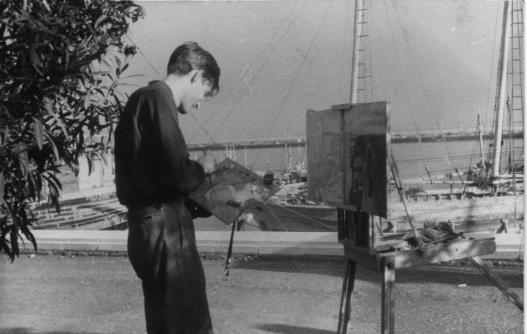
T.Galán Ulla painting the harbour of Santa Cruz in 1962
Teófilo Galán Ulla was born in Madrid.Like his father, he first of all studied to become a teacher, but after few semesters he transferred to the academy of arts in Madrid. He subsequently moved on to Barcelona, Munich and Stockholm. After his studies in art, he went back to Spain in search of the tranquillity he needed to paint and found it at last on Tenerife in 1961.
This Island offered calm, light, a constantly changing atmosphere and a climate which allowed him to paint outdoors. Here his study was the shade of a palm or a treed. Away from the bustle of the city and the tourist centres he found people who had retained their tranquil lifestyle unchanged for fifty or hundred years. They provided him with the motifs whichcan be seen in all his works, but the main theme of his paintings is always calm and light.
All works of the artist testify remarkable skill and extraordinary high artistic quality. At the same time, they manifest a dedication to beauty that has become rare today but it´s gaining nowdays more popularity with the current trend towards nostalgia. T.G.U. approaches his motifs with extraordinary meticulousness of detail. Even after he has found his subject and made his first studies or already put brush to canvas for a new painting, it only needs the atmosphere or light to change and he will stop, pack away his easel and leave. He has been known to return five or six times to the same motif and all in vain because the situation was no longer the same as when he began.
The impressionist Galán Ulla has his own subtile way of awakening in us a feeling for the beauty of southern landscapes and the people who live there through his style of painting and his choice of motifs. His impressionistic works, whether oil paintings, watercolours or graphic works always capture a fleeting impression as he has seen and experienced it personally. The evening sky is often dark brown with no trace of blue or red. This atmosphere makes the human subjects the central element of his work. He rarely paints details because the person’s movements are more important.
W. Warning